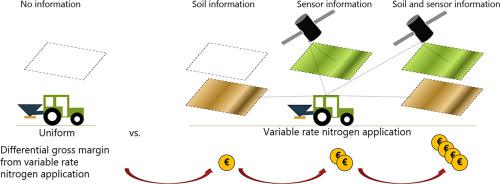Agricultural Systems ( IF 6.1 ) Pub Date : 2021-06-08 , DOI: 10.1016/j.agsy.2021.103147 Michael Friis Pedersen , Jacob Glerup Gyldengren , Søren Marcus Pedersen , Efstathios Diamantopoulos , René Gislum , Merete Elisabeth Styczen

|
CONTEXT
Variable rate nitrogen (N) management strategies are often based on information about soil texture or information from canopy sensors, mounted on ground-based vehicles or satellites. However, disentangling the effect of each information type on N management strategy with experimental studies is often difficult, as results are only valid for the specific experimental conditions as well as the weather conditions for specific years. An alternative to this is to use deterministic crop growth models to generate a wider range of weather x treatment combinations.
OBJECTIVE
This study examines if ‘static’ soil profile information or ‘dynamic’ canopy sensor type information provide a better basis for decision making concerning N-application at the subfield level.
METHODS
The DAISY model was used to simulate crop growth in a five-year crop rotation on six soil profiles found in a heterogeneous sandy loam field. A range of management descriptions and simulations were made using 5 × 500 years of synthetic weather data with each crop in a five-year rotation set at the first year of the five parallel simulations. Simulated growth variables were used as proxies for a ‘dynamic’ canopy sensor information system. The differential gross margin was then calculated for a range of price relations between fertilizer (model input) and wheat yield (model output), including wheat price adjustments according to protein content. From regressions and backward induction analysis, the N application that maximizes the expected grain revenue minus fertilizer expenditure was estimated for four information cases; Case 1) Uniform application, assuming no prior information, Case 2) application based on soil type information, Case 3) application based on canopy sensor information and Case 4) application based on combined soil and canopy sensor information.
RESULTS AND CONCLUSIONS
Findings from this study indicated that decisions with soil information alone provide an annual differential gross margin of variable rate application (without considering cost of information and technology) between 3.88 and 13.30 € ha−1 across price and soil variation. This margin approximately doubled with applications based on canopy sensor information and further doubled again with applications based on both soil and canopy sensor information.
SIGNIFICANCE
Thus, knowledge of the soil has the potential to improve interpretation of sensor signals for fertilization planning. The results may guide developers to decide on what type of information should be included in their decision support systems.
中文翻译:

基于土壤和传感器信息的冬小麦变率施氮模拟——经济可行性研究
语境
可变速率氮 (N) 管理策略通常基于有关土壤质地的信息或来自安装在地面车辆或卫星上的冠层传感器的信息。然而,通过实验研究解开每种信息类型对 N 管理策略的影响通常很困难,因为结果仅适用于特定的实验条件以及特定年份的天气条件。另一种方法是使用确定性作物生长模型来生成更广泛的天气 x 处理组合。
客观的
这项研究检验了“静态”土壤剖面信息或“动态”冠层传感器类型信息是否为在子领域级别有关施氮的决策提供了更好的基础。
方法
DAISY 模型用于模拟在异质沙壤土田中发现的六个土壤剖面上五年轮作的作物生长。使用 5 × 500 年的合成天气数据进行了一系列管理描述和模拟,每种作物在五个平行模拟的第一年的五年轮作中进行。模拟生长变量被用作“动态”冠层传感器信息系统的代理。然后根据肥料(模型输入)和小麦产量(模型输出)之间的一系列价格关系计算差异毛利率,包括根据蛋白质含量调整小麦价格。通过回归和反向归纳分析,在四个信息案例中估计了使预期粮食收入减去肥料支出最大化的施氮量;
结果和结论
这项研究的结果表明,仅根据土壤信息做出的决策提供的可变利率应用(不考虑信息和技术成本)的年度差异毛利率介于 3.88 和 13.30 欧元公顷-1之间,涵盖价格和土壤变化。对于基于冠层传感器信息的应用程序,这个余量大约翻了一番,而对于基于土壤和冠层传感器信息的应用程序,这个余量又进一步翻了一番。
意义
因此,对土壤的了解有可能改善传感器信号的解释以进行施肥规划。结果可以指导开发人员决定他们的决策支持系统中应该包含什么类型的信息。











































 京公网安备 11010802027423号
京公网安备 11010802027423号